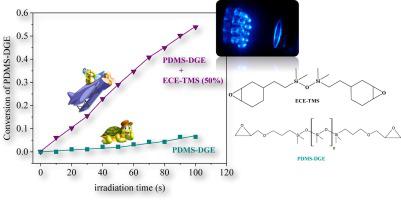当前位置:
X-MOL 学术
›
Eur. Polym. J.
›
论文详情
Our official English website, www.x-mol.net, welcomes your
feedback! (Note: you will need to create a separate account there.)
Visible-light photopolymerization of epoxy-terminated poly(dimethylsiloxane) blends: Influence of the cycloaliphatic monomer content on the curing behavior and network properties
European Polymer Journal ( IF 5.8 ) Pub Date : 2020-07-01 , DOI: 10.1016/j.eurpolymj.2020.109841 Ana C. Scanone , Ulises Casado , Walter F. Schroeder , Cristina E. Hoppe
European Polymer Journal ( IF 5.8 ) Pub Date : 2020-07-01 , DOI: 10.1016/j.eurpolymj.2020.109841 Ana C. Scanone , Ulises Casado , Walter F. Schroeder , Cristina E. Hoppe

|
Abstract Siloxane-based networks were obtained by photoinitiated cationic ring-opening polymerization of mixtures composed of two different siloxane monomers: poly(dimethylsiloxane) diglycidyl ether (PDMS-DGE) and bis [2-(3,4-epoxycyclohexyl) ethyl]-tetramethylsiloxane (ECE-TMA). The photoinitiated polymerization of PDMS-DGE is very sluggish and thus finds little use in high-speed photocuring applications. However, this monomer undergoes fast visible-light photopolymerization when combined with ECE-TMA. This behavior was ascribed to copolymerization effects induced for the higher reactivity of the cycloaliphatic epoxy monomer (ECE-TMA). It was demonstrated that the polymerization rate, as well as the thermo-mechanical properties of the resulting networks, can be adjusted by varying the ratio between both monomers. Plots of PDMS-DGE conversion versus ECE-TMA conversion evidenced a non-ideal copolymerization behavior, with a preferential addition of ECE-TMA units during the first stages of network formation. The composition of the mixture was varied over the entire range of concentrations without evidence of phase separation before or during photopolymerization at room temperature. The resulting networks exhibited a behavior that changed from a rubbery to a glassy state at room temperature depending on the mixture composition, as revealed by dynamic mechanical analysis. The storage modulus and damping factor were successfully correlated with the crosslinking density and network topology. The high transparency of the mixtures allowed to reach a high epoxy conversion by photopolymerization, even for thick samples (1–2 mm in thickness), which constitutes a significant advance for applications requiring high-speed curing protocols at ambient conditions.
中文翻译:

端环氧基聚(二甲基硅氧烷)共混物的可见光光聚合:脂环族单体含量对固化行为和网络性能的影响
摘要 硅氧烷基网络是通过光引发阳离子开环聚合由两种不同的硅氧烷单体组成的混合物获得的:聚(二甲基硅氧烷)二缩水甘油醚(PDMS-DGE)和双[2-(3,4-环氧环己基)乙基]-四甲基硅氧烷(ECE-TMA)。PDMS-DGE 的光引发聚合非常缓慢,因此在高速光固化应用中几乎没有用处。然而,当与 ECE-TMA 结合时,这种单体会发生快速的可见光光聚合。这种行为归因于脂环族环氧单体 (ECE-TMA) 的更高反应性引起的共聚效应。结果表明,可以通过改变两种单体之间的比例来调节聚合速率以及所得网络的热机械性能。PDMS-DGE 转化率与 ECE-TMA 转化率的曲线图证明了非理想的共聚行为,在网络形成的第一阶段优先添加 ECE-TMA 单元。在室温下光聚合之前或期间,混合物的组成在整个浓度范围内变化而没有相分离的迹象。正如动态力学分析所揭示的那样,所得网络表现出的行为在室温下从橡胶态变为玻璃态,这取决于混合物的组成。储能模量和阻尼因子成功地与交联密度和网络拓扑相关联。混合物的高透明度允许通过光聚合达到高环氧树脂转化率,即使对于厚样品(1-2 毫米厚),
更新日期:2020-07-01
中文翻译:

端环氧基聚(二甲基硅氧烷)共混物的可见光光聚合:脂环族单体含量对固化行为和网络性能的影响
摘要 硅氧烷基网络是通过光引发阳离子开环聚合由两种不同的硅氧烷单体组成的混合物获得的:聚(二甲基硅氧烷)二缩水甘油醚(PDMS-DGE)和双[2-(3,4-环氧环己基)乙基]-四甲基硅氧烷(ECE-TMA)。PDMS-DGE 的光引发聚合非常缓慢,因此在高速光固化应用中几乎没有用处。然而,当与 ECE-TMA 结合时,这种单体会发生快速的可见光光聚合。这种行为归因于脂环族环氧单体 (ECE-TMA) 的更高反应性引起的共聚效应。结果表明,可以通过改变两种单体之间的比例来调节聚合速率以及所得网络的热机械性能。PDMS-DGE 转化率与 ECE-TMA 转化率的曲线图证明了非理想的共聚行为,在网络形成的第一阶段优先添加 ECE-TMA 单元。在室温下光聚合之前或期间,混合物的组成在整个浓度范围内变化而没有相分离的迹象。正如动态力学分析所揭示的那样,所得网络表现出的行为在室温下从橡胶态变为玻璃态,这取决于混合物的组成。储能模量和阻尼因子成功地与交联密度和网络拓扑相关联。混合物的高透明度允许通过光聚合达到高环氧树脂转化率,即使对于厚样品(1-2 毫米厚),











































 京公网安备 11010802027423号
京公网安备 11010802027423号